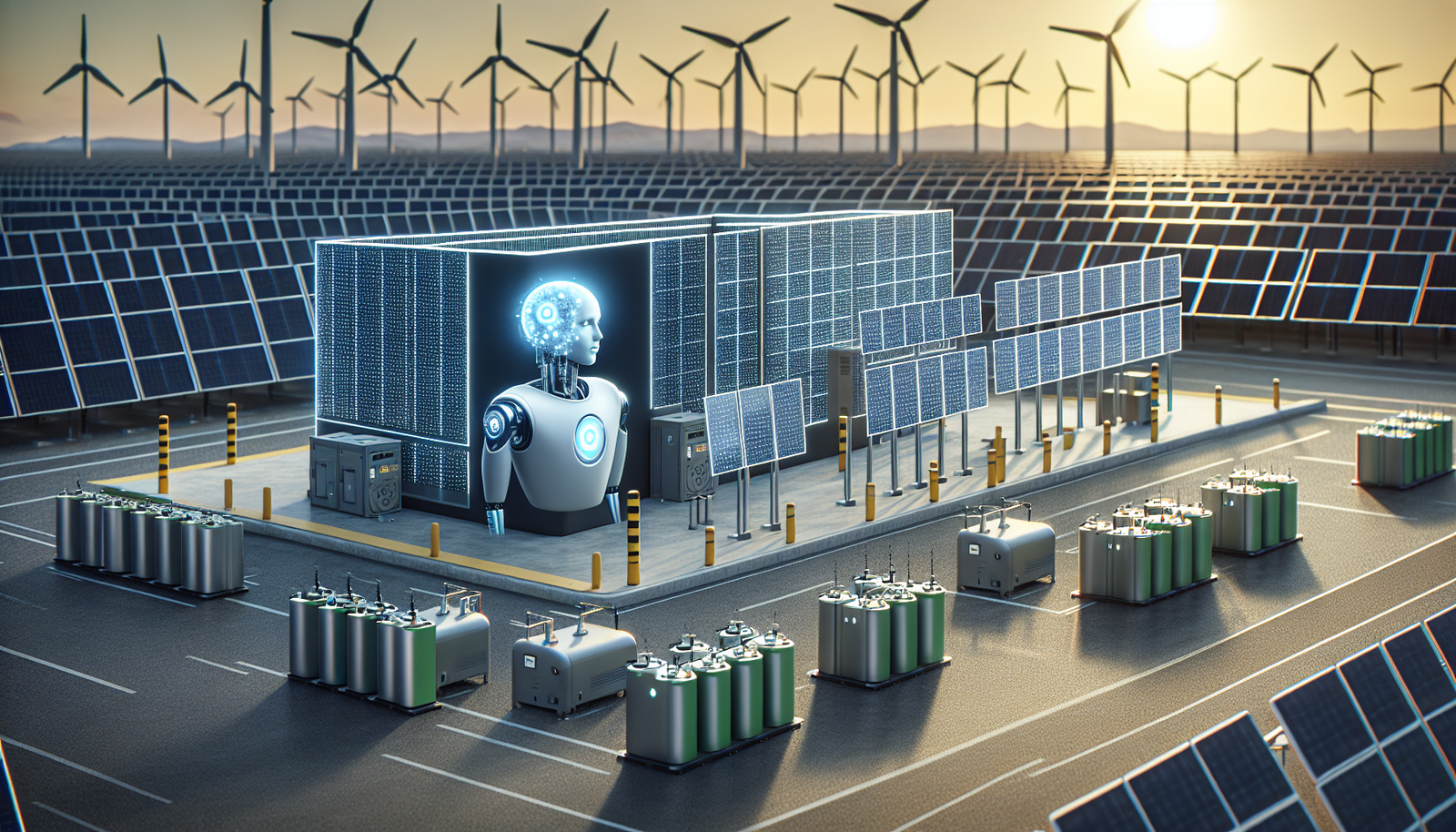AI-Driven Innovations in Energy Storage
Artificial Intelligence (AI) is at the forefront of transforming the landscape of sustainable energy storage. By leveraging advanced algorithms and machine learning techniques, AI is optimizing battery performance in unprecedented ways. It enables real-time monitoring and predictive maintenance, which are crucial for enhancing the lifespan and efficiency of energy storage systems. For instance, AI algorithms can analyze vast amounts of data from battery sensors to predict potential failures and recommend proactive measures. This not only reduces downtime but also significantly lowers maintenance costs, making sustainable energy storage solutions more viable and cost-effective.
Moreover, AI facilitates predictive analytics for renewable energy integration, which is a game-changer for the energy sector. By analyzing weather patterns, consumption trends, and other variables, AI systems can predict the availability of renewable energy sources like solar and wind. This predictive capability allows for better planning and utilization of stored energy. For example, an AI-driven system might forecast a period of low sunlight and adjust the energy storage strategy accordingly, ensuring that energy supply remains stable and reliable.
In terms of grid management, AI enhances the ability to balance supply and demand dynamically. It can optimize the distribution of stored energy across the grid, making it possible to respond efficiently to fluctuations in energy demand. This is achieved through sophisticated models that simulate various scenarios and outcomes. The implementation of these AI-driven strategies in grid management not only improves reliability but also supports the integration of a higher percentage of renewable energy into the grid.
- Challenges: Integrating AI with sustainable materials poses several challenges, such as ensuring compatibility and efficiency.
- Opportunities: The development of AI algorithms tailored for energy storage materials offers vast opportunities for innovation.
| Aspect | AI Application | Benefit |
|---|---|---|
| Battery Performance | Real-time Monitoring | Prolonged Lifespan |
| Renewable Integration | Predictive Analytics | Optimized Energy Use |
| Grid Management | Dynamic Balancing | Increased Reliability |
Machine Learning for Battery Optimization
Machine learning is playing a crucial role in the field of battery optimization, particularly through the enhancement of battery life and efficiency. By leveraging advanced algorithms, machine learning models can analyze vast amounts of data generated by battery usage patterns. These models help in predicting the health and lifespan of batteries more accurately than traditional methods. This not only aids in timely maintenance but also helps in designing batteries that last longer and perform better.
One of the significant advantages of using machine learning for battery optimization is its ability to identify and mitigate issues that might lead to battery degradation. For instance, predictive analytics can forecast potential failures or inefficiencies in battery systems, allowing for preemptive action. This approach reduces downtime and enhances the reliability of energy storage systems, which is crucial for maintaining a steady supply of renewable energy.
The application of machine learning in battery optimization is further enhanced by the integration of real-time data analysis. This capability allows for the continuous monitoring of batteries, enabling adjustments to be made in real-time to improve performance. Below is an example of how machine learning models can be structured to optimize battery performance:
| Model Type | Functionality | Benefits |
|---|---|---|
| Supervised Learning | Predicts battery life based on historical data | Improves accuracy in lifespan estimation |
| Unsupervised Learning | Identifies patterns in battery usage | Helps in anomaly detection |
| Reinforcement Learning | Optimizes charging cycles | Enhances battery efficiency |
Despite the promising advantages, integrating machine learning with battery technology presents several challenges. These include the need for large datasets to train models effectively and the complexity of developing algorithms that can accurately simulate real-world conditions. Nevertheless, as technology advances, the potential for machine learning to revolutionize battery optimization continues to grow, offering exciting opportunities for the sustainable energy sector.
Predictive Analytics for Renewable Energy
Predictive analytics is playing a pivotal role in enhancing the efficiency and reliability of renewable energy systems. By leveraging AI-driven models, energy providers can forecast energy production and consumption patterns with remarkable accuracy. This capability is particularly crucial for renewable sources like solar and wind, where energy generation is inherently variable. Predictive analytics enables operators to anticipate fluctuations in energy supply and demand, allowing for more efficient grid management and reducing reliance on fossil fuel-based backup systems.
Benefits of Predictive Analytics in Renewable Energy:
- Optimized Resource Allocation: Predictive models help in forecasting energy demand, enabling more strategic resource allocation and reducing waste.
- Enhanced Grid Stability: By predicting energy output from renewable sources, grid operators can maintain a stable power supply, minimizing the risks of blackouts.
- Cost Reduction: Accurate predictions allow for better financial planning and reduced operational costs by minimizing energy wastage and optimizing maintenance schedules.
One of the key challenges in implementing predictive analytics is the integration of large datasets from varied sources, such as weather forecasts and historical energy usage patterns. AI algorithms analyze these datasets to generate insights, which are then used to make informed decisions about energy distribution and storage. This data-driven approach not only improves the efficiency of renewable energy systems but also supports the transition towards a more sustainable energy future.
Table: Key Predictive Analytics Techniques in Renewable Energy
| Technique | Description | Application |
|---|---|---|
| Time Series Analysis | Analyzes historical data to predict future energy demand and supply trends. | Optimizing grid operation and energy storage utilization. |
| Machine Learning | Uses algorithms to learn from data and improve prediction accuracy over time. | Forecasting renewable energy production with high precision. |
| Weather Modeling | Integrates meteorological data to anticipate changes in renewable energy output. | Improving solar and wind energy reliability. |
Intelligent Grid Management
Intelligent grid management is a critical component in the integration of AI with sustainable energy storage solutions. By leveraging AI technologies, energy providers can enhance the efficiency and reliability of power grids. AI algorithms can process vast amounts of data from various sources, such as weather forecasts, energy consumption patterns, and grid performance metrics, to optimize energy distribution. This not only helps in reducing energy waste but also in maintaining a stable supply of renewable energy.
One of the primary benefits of AI in grid management is its ability to predict and mitigate potential grid failures. Through predictive analytics, AI systems can identify patterns and irregularities that may indicate an impending failure. This allows for proactive maintenance and swift response to issues, minimizing downtime and service disruptions. The implementation of AI-driven solutions can also facilitate the integration of diverse energy sources, balancing the load between solar, wind, and traditional power plants.
The use of AI in grid management also presents opportunities for more dynamic and adaptive grid operations. AI can enable demand-response strategies that adjust energy consumption based on availability and price signals. This adaptability not only supports grid stability but also encourages consumer participation in energy-saving initiatives. Moreover, AI-driven microgrids can operate independently or in conjunction with the main grid, providing localized energy solutions that enhance resilience and sustainability.
| Benefits of AI in Grid Management | Challenges |
|---|---|
|
|
AI and the Future of Hydrogen Storage
Artificial Intelligence (AI) is playing a pivotal role in the advancement of hydrogen storage technologies, which are critical for the transition to sustainable energy solutions. Hydrogen, as a clean energy carrier, offers immense potential, but its storage poses significant challenges due to its low energy density and the high costs associated with current storage methods. AI is being leveraged to address these challenges by optimizing storage processes and materials. By utilizing machine learning algorithms, AI systems can analyze vast datasets to predict the most efficient storage methods, leading to enhanced energy efficiency and reduced costs.
One of the primary areas where AI contributes is in the optimization of materials used for hydrogen storage. For instance, AI can evaluate and predict the properties of new materials that may offer better hydrogen absorption and retention. This process involves the analysis of complex data sets obtained from experimental results and simulations, which AI can process much faster than traditional methods. The development of advanced materials could lead to significant improvements in storage capacity and stability.
Moreover, AI aids in the predictive analytics necessary for efficient hydrogen supply chain management. By analyzing patterns in data, AI systems can forecast demand and optimize the distribution of hydrogen resources. This capability is crucial for maintaining balance in the energy grid, especially when integrating hydrogen with other renewable energy sources like wind and solar. The predictive models help in minimizing waste and ensuring a reliable energy supply.
The integration of AI in hydrogen storage solutions also presents several ethical considerations. The deployment of AI systems must ensure data privacy and security, especially given the sensitive nature of energy infrastructure. Furthermore, policymakers need to consider the implications of AI-driven decisions on the workforce and public safety. As AI continues to evolve, its role in hydrogen storage will undoubtedly expand, presenting both opportunities and challenges that need to be carefully managed.
Enhancing Energy Efficiency with AI
The integration of Artificial Intelligence (AI) into energy systems is significantly enhancing energy efficiency, offering a promising pathway toward more sustainable energy storage solutions. AI algorithms can optimize energy consumption patterns by analyzing vast amounts of data and identifying inefficiencies. This capability allows for smarter energy use, reducing waste and maximizing the use of renewable resources. For instance, AI-driven systems can predict energy demand peaks and adjust the energy distribution accordingly, ensuring that stored energy is utilized most effectively.
One of the key areas where AI is making an impact is in the management of battery systems. By employing machine learning techniques, AI can predict battery life cycles and improve charge-discharge cycles. This not only extends the lifespan of batteries but also enhances their performance, making them more reliable and efficient. A study has shown that AI can improve battery efficiency by up to 20%, which translates into significant energy savings over time.
Moreover, AI can support predictive maintenance in energy systems, reducing downtime and maintenance costs. By analyzing data from various sensors, AI can foresee potential failures and suggest timely interventions. This proactive approach not only enhances the reliability of energy storage systems but also contributes to the overall efficiency of the energy grid. As AI continues to evolve, its capability to integrate with other technologies such as Internet of Things (IoT) devices will further enhance energy management systems.
Below is a table illustrating the potential improvements in energy efficiency with AI integration:
| AI Application | Efficiency Improvement |
|---|---|
| Energy Consumption Optimization | Up to 30% |
| Battery Performance Enhancement | Up to 20% |
| Predictive Maintenance | Reduction in Downtime by 15% |
AI’s Impact on Battery Recycling
Artificial Intelligence (AI) is playing a pivotal role in revolutionizing battery recycling processes, which are crucial for sustainable energy storage solutions. By leveraging AI technologies, companies are optimizing the collection, sorting, and recycling of batteries, thereby enhancing efficiency and reducing environmental impact. Machine learning algorithms can analyze vast amounts of data to identify patterns and improve the accuracy of sorting batteries based on their chemical compositions. This not only speeds up the recycling process but also minimizes human error.
One significant advantage of using AI in battery recycling is its ability to predict the lifespan and degradation patterns of batteries. This predictive capability allows for more effective recycling strategies and better resource allocation. AI models can simulate various recycling scenarios, helping to identify the most sustainable and economically viable options. Moreover, AI-driven robotics and automation are increasingly used to handle and sort batteries, reducing the risk of exposure to hazardous materials for human workers.
The integration of AI in battery recycling also presents a unique set of challenges. For instance, the need for high-quality data to train AI systems is paramount, and obtaining such data can be difficult due to the diverse nature of battery designs and chemistries. Furthermore, ethical considerations arise concerning the deployment of AI technologies, such as ensuring transparency in AI decision-making processes and addressing potential biases in algorithmic predictions. Despite these challenges, the opportunities for AI to enhance battery recycling are vast, promising a future of more sustainable energy storage solutions.
As we look to the future, the role of AI in battery recycling is expected to expand, with emerging trends focusing on the development of more advanced AI models and the incorporation of sustainable materials. By fostering collaboration between AI developers and battery manufacturers, the industry can drive innovation and achieve significant environmental benefits. Continued research and investment in AI technologies will be essential to unlocking the full potential of sustainable battery recycling.
Sustainable Materials and AI Integration
The integration of AI with sustainable materials in energy storage solutions presents a groundbreaking opportunity to enhance both efficiency and environmental impact. Sustainable materials, such as organic polymers and bio-derived substances, are increasingly being used in the development of eco-friendly batteries. AI algorithms can optimize the selection and processing of these materials by analyzing vast datasets to determine the most effective combinations for energy storage. For instance, machine learning models can predict the performance characteristics of new material formulations before they are physically tested, significantly reducing the time and resources required for experimentation.
AI’s capacity to analyze and interpret complex data enables it to identify patterns and correlations that may not be immediately apparent to human researchers. This capability is particularly useful when dealing with the diverse range of variables involved in sustainable material development. Predictive analytics powered by AI can forecast the long-term stability and degradation patterns of these materials under various environmental conditions. As a result, researchers can fine-tune the material properties to enhance durability and efficiency, ultimately leading to more reliable and sustainable energy storage solutions.
However, the integration of AI with sustainable materials is not without its challenges. One major issue is the availability and quality of data needed to train AI models effectively. There is often a lack of comprehensive datasets that cover the broad spectrum of potential material combinations and their behaviors. To address this, collaborative efforts within the scientific community are essential to build extensive databases through shared research and open-source initiatives. Furthermore, ethical considerations must be taken into account, ensuring that the development of AI-driven sustainable materials does not inadvertently lead to the depletion of natural resources or ecological harm.
The future trends in this field are promising, with ongoing advancements in AI technology and sustainable material science paving the way for innovative solutions. The potential for AI to revolutionize sustainable energy storage is immense, offering the possibility of creating storage systems that are not only efficient but also environmentally benign. As the technology continues to evolve, it is crucial to maintain a balance between innovation and sustainability, ensuring that AI-driven developments contribute positively to the global energy landscape.
Smart Energy Forecasting
Smart energy forecasting is a critical component in the integration of AI with sustainable energy storage systems. By leveraging advanced algorithms and machine learning techniques, AI can predict energy production and consumption patterns with remarkable accuracy. This capability is essential for managing the intermittent nature of renewable energy sources such as solar and wind. For instance, AI can analyze weather patterns and historical data to forecast energy generation, allowing for more effective scheduling of energy storage and distribution.
An example of AI’s impact in this area is its ability to optimize battery usage. Predictive analytics can inform decisions on when to charge or discharge storage systems, thus prolonging battery life and reducing costs. By predicting peak demand periods, AI systems can ensure that sufficient energy is stored and available when needed, enhancing the stability and reliability of the grid. The following table illustrates the improvements in forecast accuracy with AI integration:
| Method | Accuracy Rate (%) |
|---|---|
| Traditional Models | 75 |
| AI-Enhanced Models | 92 |
Furthermore, smart energy forecasting can aid in balancing supply and demand, minimizing energy wastage, and reducing reliance on fossil fuels. AI systems can utilize real-time data to adjust energy flows dynamically, ensuring optimal performance of the entire energy ecosystem. This adaptability not only supports sustainability goals but also provides economic benefits by reducing operational costs. As AI technologies continue to evolve, their integration with sustainable energy storage solutions promises to revolutionize how we harness and utilize renewable energy.
Challenges and Opportunities in AI Energy Solutions
Challenges in AI Energy Solutions: The integration of AI in sustainable energy storage systems presents several challenges. One significant issue is the complexity of data management. As AI systems require vast amounts of data to function effectively, the process of collecting, storing, and analyzing this data can be resource-intensive. There is also the challenge of ensuring data security and privacy, as sensitive information can be vulnerable to cyber threats. Additionally, the interoperability of AI technologies with existing infrastructure and systems is crucial, yet often difficult to achieve due to the diversity of technologies and standards in the energy sector.
Another challenge is the cost of implementation. Developing and deploying AI systems requires significant financial investment, which can be a barrier for smaller companies or developing regions. Furthermore, there is an ongoing need for skilled personnel who can design, implement, and maintain AI systems, which adds to the operational costs. Finally, the regulatory environment surrounding AI in energy storage is still evolving, creating uncertainty for businesses looking to innovate in this space.
Opportunities in AI Energy Solutions: Despite these challenges, AI offers numerous opportunities that can revolutionize the energy storage landscape. One of the most promising aspects is the optimization of energy usage. AI can analyze patterns in energy consumption and production, allowing for more efficient energy distribution and reducing waste. This is particularly beneficial in managing the variability of renewable energy sources like solar and wind.
The development of predictive maintenance systems is another opportunity. AI can forecast equipment failures before they occur, minimizing downtime and maintenance costs. Additionally, AI can enhance grid management systems by providing real-time insights and automated responses to changes in energy demand and supply. These capabilities not only improve the reliability of energy systems but also support the integration of more renewable energy sources.
| Challenges | Opportunities |
|---|---|
|
|
The Ethical Implications of AI in Energy
The integration of Artificial Intelligence (AI) in energy storage solutions presents a complex array of ethical considerations. As AI systems become more entrenched in optimizing and managing energy resources, questions about data privacy and security become paramount. Data collection and usage are at the forefront of these concerns, as AI relies heavily on vast amounts of data to function effectively. Energy companies must ensure that they are safeguarding consumer data while also being transparent about how this data is utilized. There is a delicate balance between leveraging AI for efficiency and maintaining the trust and privacy of individuals.
Moreover, the deployment of AI in energy raises concerns about job displacement. As AI systems take over tasks traditionally performed by humans, there is potential for significant changes in the workforce. On one hand, AI can create new opportunities in tech-driven roles, but on the other hand, it may render certain positions obsolete. Companies and policymakers must therefore consider strategies for workforce transition and retraining to mitigate these impacts. A focus on ethical labor practices and the development of new skill sets will be crucial to ensure that the benefits of AI-driven energy solutions are equitably distributed.
Another ethical dimension involves the biases inherent in AI algorithms. If not carefully managed, AI can perpetuate existing inequalities in energy access and distribution. For instance, algorithms trained on biased data may prioritize energy distribution to more affluent areas, further disadvantaging marginalized communities. It is essential to adopt inclusive approaches when developing AI models, ensuring that they are designed with fairness and equity in mind. This requires a concerted effort to audit AI systems and incorporate diverse datasets that reflect the needs of all societal segments.
Finally, the broader environmental impact of AI technologies cannot be overlooked. While AI contributes to more efficient energy storage and reduced emissions, the technology itself requires substantial computational power, which can lead to increased energy consumption. A key ethical consideration is the development of AI systems that are not only effective but also energy-efficient. This involves creating sustainable AI models that minimize their carbon footprint, thereby aligning with the overarching goals of sustainable energy initiatives.
Future Trends and Predictions for AI in Energy Storage
The integration of Artificial Intelligence (AI) in energy storage systems is expected to drive significant advancements in the coming years. As the demand for sustainable energy solutions grows, AI technologies are poised to enhance the efficiency and reliability of energy storage systems. One of the key trends is the development of intelligent battery management systems that utilize AI algorithms to optimize charging and discharging cycles, extending battery life and improving performance. This not only increases the sustainability of battery storage but also reduces costs for end users.
Another future trend involves the use of AI in predictive analytics for energy storage. By analyzing extensive datasets from renewable energy sources, AI can predict energy production patterns and consumption needs more accurately. This capability allows for better integration of renewable sources into the energy grid, minimizing waste and ensuring that energy supply matches demand. AI’s role in predictive maintenance is also expected to grow, as it can forecast potential system failures before they occur, thus reducing downtime and maintenance costs.
Moreover, AI is set to play a crucial role in the development of new, sustainable materials for energy storage. By leveraging AI-driven simulations and material science, researchers can discover and develop materials that offer higher energy density and environmental sustainability. These advancements could lead to breakthroughs in the capabilities of energy storage systems, making them more efficient and less reliant on scarce resources. The ethical implications of AI in energy storage also present an evolving area of consideration, as stakeholders must address concerns about data privacy, security, and the equitable distribution of AI benefits.
In summary, the future of AI in energy storage is characterized by a range of promising trends and predictions. As AI continues to evolve, it will likely unlock new opportunities for optimizing energy systems, integrating renewable resources, and driving innovation in sustainable materials. However, alongside these exciting advancements, there will be a need for careful consideration of ethical issues and potential challenges in implementing AI technologies on a wide scale.



